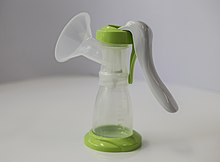Breast pump
A breast pump (also called a breast pump ) is an aid for expressing breast milk . It is used when normal breastfeeding is not possible (see also: Pump breastfeeding ). In this case, regular expressing maintains the ability to breastfeed and can prevent premature weaning.
A suction cup-like glass or plastic attachment (mostly polypropylene) is placed on the breast , the so-called breast cup. A vacuum generator then sucks the breast milk out of the breast. The materials of the top sections and the milk container are skin-friendly and food-safe, so they can also be used by allergy sufferers. The vacuum can - depending on the model - be generated manually using a hand pump or electrically. In a first phase (stimulation phase), the milk flow (see also milk dispensing reflex ) is stimulated, in a second phase (pumping phase) the actual pumping process follows. There is also the option of pumping both sides at the same time with the double breast pump.
Possible reasons for use are:
- if the mother is unable to breastfeed the child for various reasons, but she would like to feed the baby with breast milk as well or only (illness, inverted warts, work, etc.)
- if the infant is unable to suckle for various reasons ( premature baby in the incubator , cleft lip and palate , general weakness of the infant)
- during a temporary silent strike
- when the mother does not want to breastfeed in public
- to prevent milk congestion
The expressed milk is then stored in so-called breast milk bags. These are made of food-safe materials, are sterilized and airtight. The storage conditions are as follows:
- at room temperature: a maximum of 6 to 8 hours
- Refrigerator: at approx. 4 degrees up to 72 hours (the longer the storage, the fewer vitamins are contained)
- Freezer: up to minus 40 degrees 6 months (volume increases when freezing)
The warm milk is offered to the infant in the baby bottle . It also allows the mother to prepare a small supply of breast milk that can be frozen if necessary.
Many pharmacies also offer the devices for rent. If there is a medical prescription, the rental costs are covered by the health insurance companies.
The experimental physicist Johann Gottlieb Stegmann (1725–1795) from Kassel developed and described a “breast or milk pump” . However, Carl Baunscheidt is considered the inventor of the modern breast pump . The simple model (around 1855) consisted of a kind of glass trumpet (funnel) with a bulge at the bottom to collect the milk and an attached rubber suction ball that is pressed together by hand.
On October 4, 1927, Edward Lasker received a patent for the first electric breast pump.

